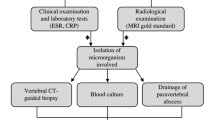Abstract
Purpose
Dynamic contrast-enhanced (DCE)-MRI is used for examining the features of malignant tumours in radiology, and we can obtain more information in terms of the diffusion of the media over the course of time. The purpose of this study was to clarify the usefulness of DCE-MRI for distinguishing pyogenic spondylitis (PS) and tuberculous spondylitis (TB).
Methods
Forty-five consecutive patients diagnosed with PS (68.6 ± 11.1 years old, males 30 and females 15) and 14 with TB (73.9 ± 9.1 years old, males 6 and females 8) were involved. DCE-MRI consisted of serial six sagittal images which were taken every 20 s after intravenous gadolinium administration. Degree of enhancement, presence of epidural abscess, presence of necrosis in vertebra, presence of enhancement in disc lesion, pattern of diffusion, and maximum contrast index were examined and compared between PS and TB.
Results
Degree of enhancement, percentage of epidural abscess, and percentage of necrosis in vertebra were 2.1 ± 0.5 and 1.8 ± 0.8, 60.7% and 100%, 50.0% and 66.7% for PS and TB, respectively, without statistical difference. Maximum contrast index, percentage of the diffusion pattern from the disc, and percentage of enhanced disc were 108.1 ± 22.3 and 78.2 ± 35.6 s, 89.3% and 0%, and 53.6% and 0% for PS and TB, respectively, with statistical significance.
Conclusions
This study indicated that longer maximum contrast index, higher likelihood of diffusion pattern from the disc, and higher likelihood of enhanced disc are more specific to PS than TB. This less invasive imaging technique is useful for more accurate diagnosis of PS and TB.
Graphic abstract
These slides can be retrieved under Electronic Supplementary Material.







Similar content being viewed by others
References
Lora-Tamayo J, Euba G, Narvaez JA et al (2011) Changing trends in the epidemiology of pyogenic vertebral osteomyelitis: the impact of cases with no microbiologic diagnosis. Semin Arthritis Rheum 41:247–255
Luzzati R, Giacomazzi D, Danzi MC et al (2009) Diagnosis, management and outcome of clinically- suspected spinal infection. J Infect 58(4):259–265
Chang MC, Wu HT, Lee CH et al (2006) Tuberculous spondylitis and pyogenic spondylitis: comparative magnetic resonance imaging features. Spine (Phila Pa 1976) 31(7):782–788
Frel M, Bialecki J, Wieczorek J et al (2017) Magnetic resonance imaging in differential diagnosis of pyogenic spondylodiscitis and tuberculous spondylodiscitis. Pol J Radiol 82:71–87
Lee Y, Kim BJ, Kim SH et al (2018) Comparative analysis of spontaneous infectious spondylitis: pyogenic versus tuberculous. J Korean Neurosurg Soc 61(1):81–88
Kim K, Kim S, Lee YH et al (2018) Performance of the deep convolutional neural network based magnetic resonance image scoring algorithm for differentiating between tuberculous and pyogenic spondylitis. Sci Rep 8(1):13124
Li T, Li W, Du Y et al (2018) Discrimination of pyogenic spondylitis from brucellar spondylitis on MRI. Medicine (Baltimore) 97(26):e11195
Türkbey B, Thomasson D, Pang Y et al (2010) The role of dynamic contrast-enhanced MRI in cancer diagnosis and treatment. Diagn Interv Radiol 16(3):186–192
Vos PC, Hambrock T, Barenstz JO et al (2010) Computer-assisted analysis of peripheral zone prostate lesions using T2-weighted and dynamic contrast enhanced T1-weighted MRI. Phys Med Biol 55(6):1719–1734
Makkat S, Luypaert R, Sourbron S et al (2010) Assessment of tumor blood flow in breast tumors with T1-dynamic contrast-enhanced MR imaging: impact of dose reduction and the use of a prebolus technique on diagnostic efficacy. Magn Reson Imaging 31(3):556–561
Mahfouz AE, Hamm B, Wolf KJ (1994) Peripheral washout: a sign of malignancy on dynamic gadolinium-enhanced MR images of focal liver lesions. Radiology 190(1):49–52
Lang N, Yuan H, Yu HJ et al (2017) Diagnosis of spinal lesions using heuristic and pharmacokinetic parameters measured by dynamic contrast-enhanced MRI. Acad Radiol 24(7):867–875
Zielonka TM, Demkow U, Michalowska-Mitczuk D et al (2011) Angiogenic activity of sera from pulmonary tuberculosis patients in relation to IL-12p40 and TNFα serum levels. Lung 189(4):351–357
Seyedmajidi M, Shafaee S, Hashemipour G et al (2015) Immunohistochemical evaluation of angiogenesis related markers in pyogenic granuloma of gingiva. Asian Pac J Cancer Prev 16(17):7513–7516
Oehlers SH, Cronan MR, Scott NR et al (2015) Interception of host angiogenic signalling limits mycobacterial growth. Nature 29(517(7536)):612–615
Kuribayashi H, Worthington PL, Bradley DP et al (2007) Misregistration artifacts in image-derived arterial input function in non-echo-planar imaging-based dynamic contrast-enhanced MRI. J Magn Reson Imaging 25(6):1248–1255
Author information
Authors and Affiliations
Corresponding author
Ethics declarations
Conflict of interest
In this study, the authors have no potential conflict of interest.
Additional information
Publisher's Note
Springer Nature remains neutral with regard to jurisdictional claims in published maps and institutional affiliations.
Electronic supplementary material
Below is the link to the electronic supplementary material.
Rights and permissions
About this article
Cite this article
Miyamoto, H., Akagi, M. Usefulness of dynamic contrast-enhanced magnetic resonance images for distinguishing between pyogenic spondylitis and tuberculous spondylitis. Eur Spine J 28, 3011–3017 (2019). https://doi.org/10.1007/s00586-019-06057-3
Received:
Revised:
Accepted:
Published:
Issue Date:
DOI: https://doi.org/10.1007/s00586-019-06057-3




